No.
One of the common arguments you hear from people in America who are not fans of the idea of electric vehicles is that they are mostly charged from electricity produced from coal power plants. And hence, while electric vehicles themselves produce zero carbon emissions, charging them increases the amount of electricity generated from fossil fuel energy sources such as coal. And so “EVs are bad.”

I recently came across the tweet above and responded to it with the tweet and chart below.

Last year I wrote an article — Electric Vehicles Have Lower Well-to-Wheel Emissions in All 50 States and DC Than Gas-Powered Vehicles — looking at “well to wheel” from the US Department of Energy and my own analysis of EV sales and source of electricity by state. The tweet from the cryptocurrency communications executive prompted me to update my analysis with the latest data.
Heavy Coal-Using States Accounted for Only 10% of EV Sales in 2020
The argument that EVs are powered mostly from coal simply isn’t true. At a high level, 15 states with 25% or more of electricity from renewable sources accounted for 53.5% of EV sales in 2020.
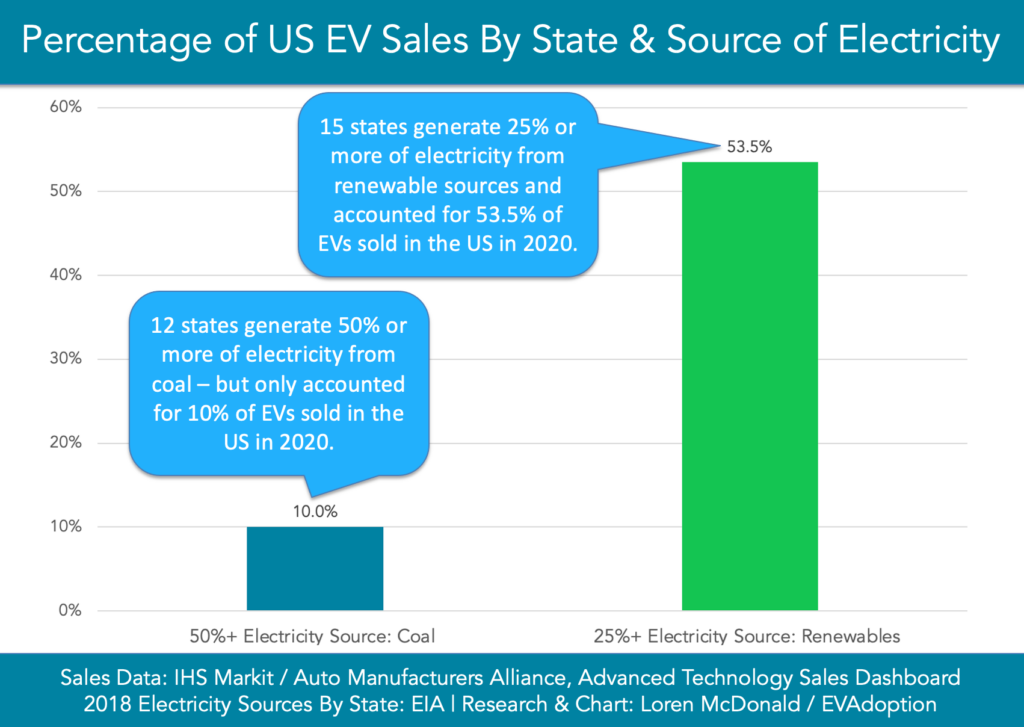
OK, well if you drive an EV in West Virginia it is true, as that state produces roughly 94% of its electricity from coal power plants. But the problem with an example like that is that in 2020, West Virginia only accounted for 0.1% of electric vehicle sales in the US. Residents of the “Mountain State” only purchased 309 EVs (195 BEVs and 114 PHEVs) last year, while Californian’s purchased 120,793. Said another way, residents of California purchased 390.9 times the number of EVs than households in West Virginia. And oh BTW, according to the Energy Information Administration, California’s grid overall consumed 0% coal power.
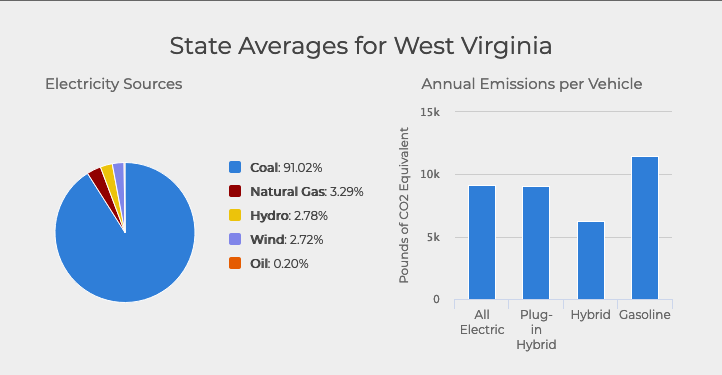
But even West Virginia, the state with the highest coal percentage of energy sources powering its grid, the DOE’s analysis shows that driving either a BEV or PHEV still has lower annual well to wheels emissions than a gas-powered vehicle.
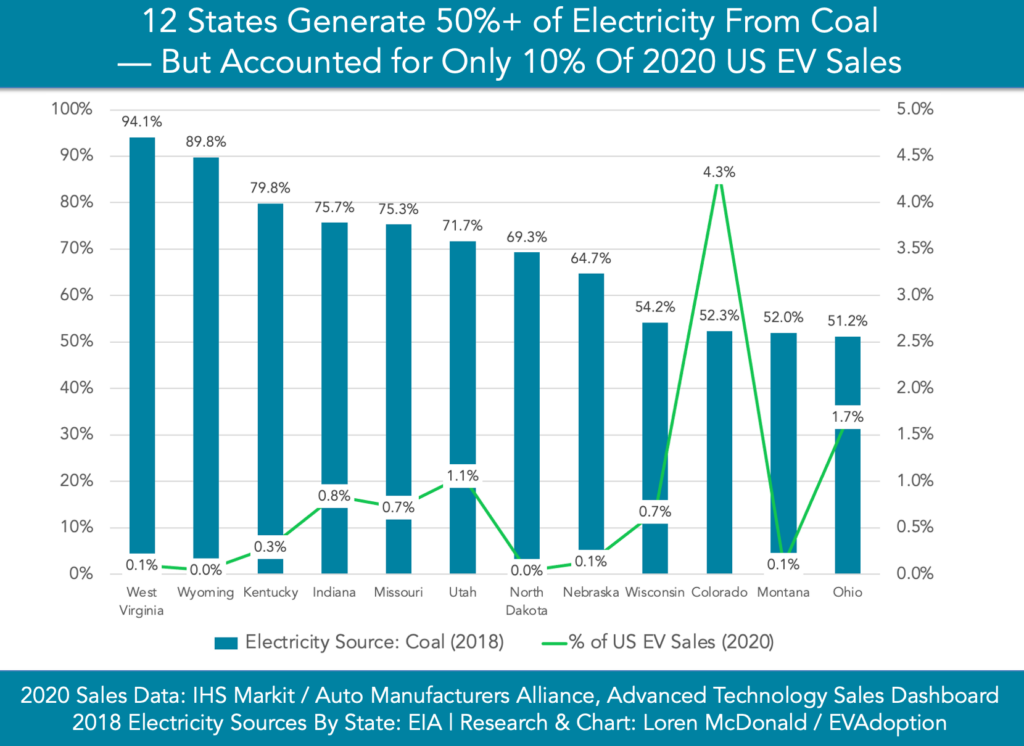
Looking at the chart above (see my note at the end about the data and caveats) you can see that there are 12 states in the US where consumption of coal as the source of electricity is at least 50 percent. But except for the state of Colorado, the other 11 states accounted for from 0% to 1.7% of US EV sales in 2020.
These 12 “coal” states combined for a total of 10% of 2020 EV sales, but without the outlying state of Colorado at 4.3%, the other 11 states would account for only 5.7% of sales. The point isn’t to argue that some EVs are not charged from electricity produced mostly from coal, but that those that are charged from primarily coal-sourced electricity is just a very small number and percentage of US EV sales. And the reality is that the grid in many parts of the country will get greener at a faster rate than the EV sales share.
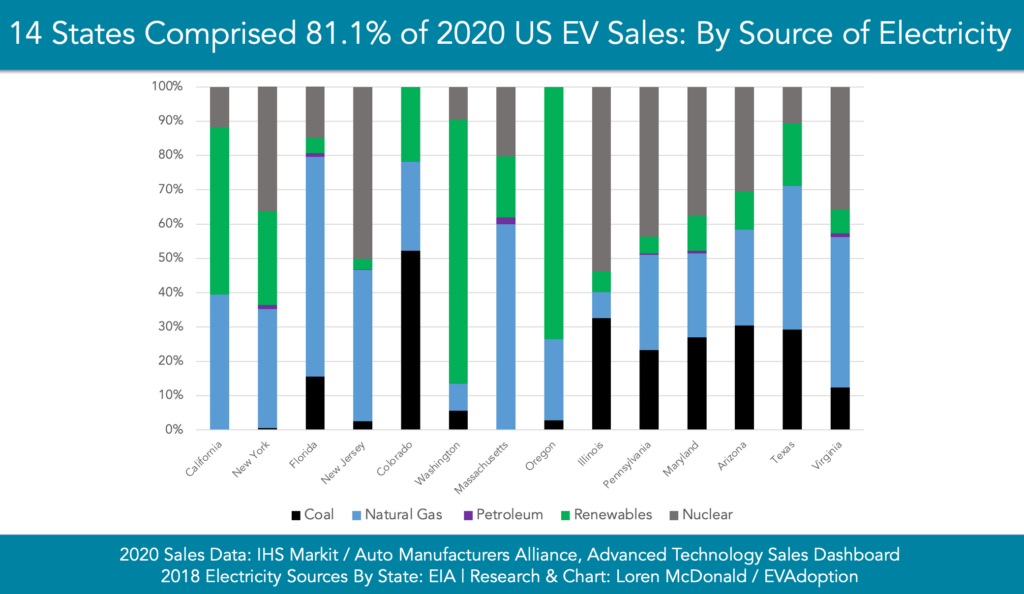
On the flip side, 14 states with the highest EV sales accounted for 81.1% of US EV sales in 2020. And of those states, only two states — the aforementioned Colorado — and Illinois have more than 30% of their electricity from coal.
And 15 states (chart below) with renewable energy sources of 25% or more combined for 53.5% of US EV sales in 2020. More impressively, 4 of these states (California, New York, Washington, and Oregon) accounted for 50.8% of EVs sold in the US in 2020.
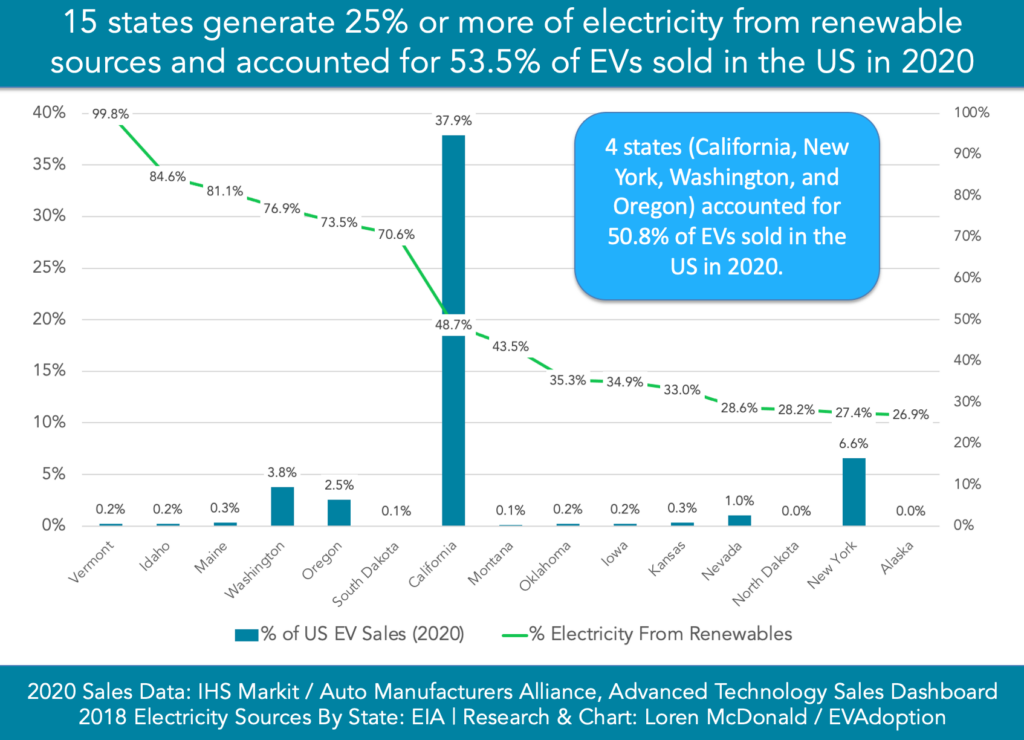
The argument that EVs are mostly powered by electricity made from coal simply doesn’t hold water. Yes, the electrical grids in many states in the US are still powered from coal, but with one exception (Colorado) people in those states simply buy very few electric vehicles. I expect that the states with greenest grids will also continue to adopt EVs at a faster rate than high coal-powered grid states.

According to the EIA, from 2011 to mid-2020, 95 gigawatts (GW) of coal capacity was closed or switched to another fuel and another 25 GW is slated to shut down by 2025. These closures will decrease the capacity of the U.S. coal fleet to less than 200 GW, more than one-third lower than its peak of 314 GW in 2011.
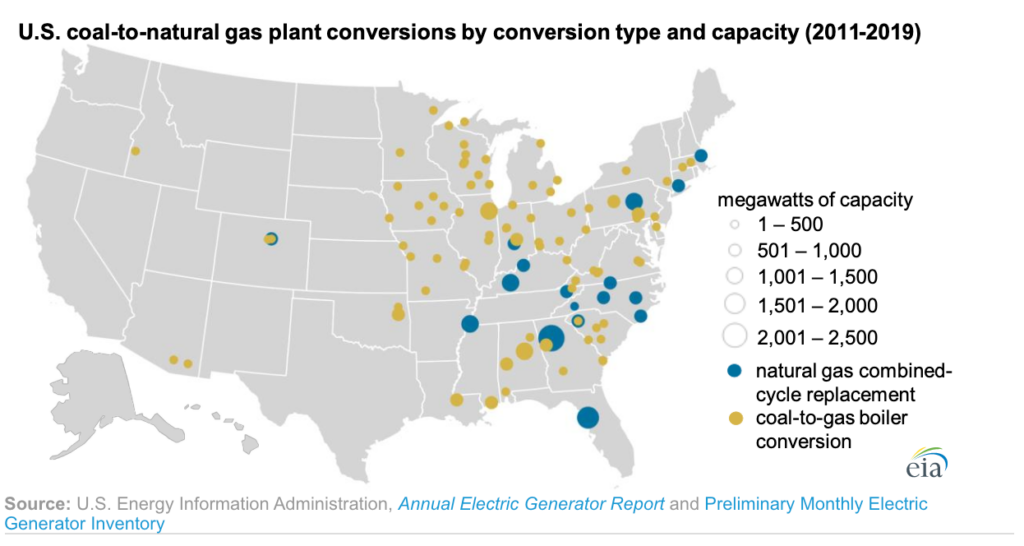
But there is some good news/bad news with these closures. The EIA says that 121 U.S. coal-fired power plants were repurposed to burn other types of fuels between 2011 and 2019, 103 of which were converted to or replaced by natural gas-fired plants. The good news of course is that coal as a source of electricity in the US is clearly on a rapid decline, due mostly to cheaper natural gas.
And that’s the so-so news of one fossil fuel replacing another. However, while still a fossil fuel, natural gas emits 50 to 60 percent less carbon dioxide (CO2 when combusted in a new, efficient natural gas power plant compared with emissions from a typical new coal plant. So the net effect is that every day that passes, EVs are increasingly charged from energy sources that emit fewer carbon emissions and pollutants. And that’s good news.
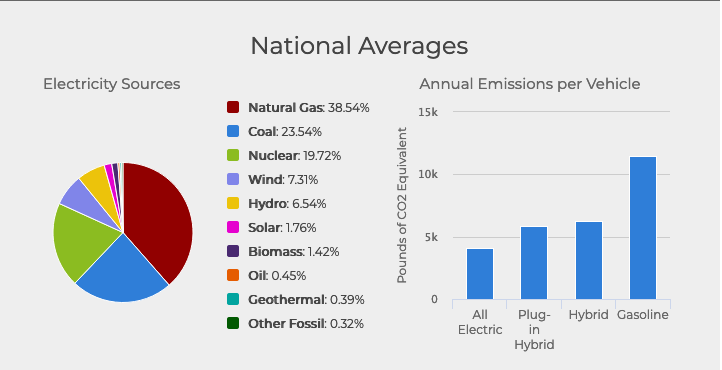
Electric vehicles are not perfect, but even those powered from electricity sourced from 50% or more of fossil fuel energy produce fewer annual emissions than gas-powered cars.
If you want to argue that electric vehicles are charged from electricity produced from coal, that’s fine. Just don’t leave out the part about how few EVs that actually is in the US.
Notes and Caveats: To be clear, the intent of this article is not to suggest that the data and analysis are perfect. In fact it is important to note several caveats on the data but to also recognize the goal of the article and analysis is to refute the general argument that electric vehicles in the US are powered mostly from coal. Following are key notes and caveats:
- 2020 versus 2018: The EV sales data is for the year 2020, whereas the EIA electricity consumption data is for 2018, the latest full year percentage data available.
- Electricity consumption data: The EIA data is reported as “consumption” for a state on an overall basis, but in a state like California with 3 large electric utilities and many smaller community providers, the actual specific sources might vary greatly by each utility.
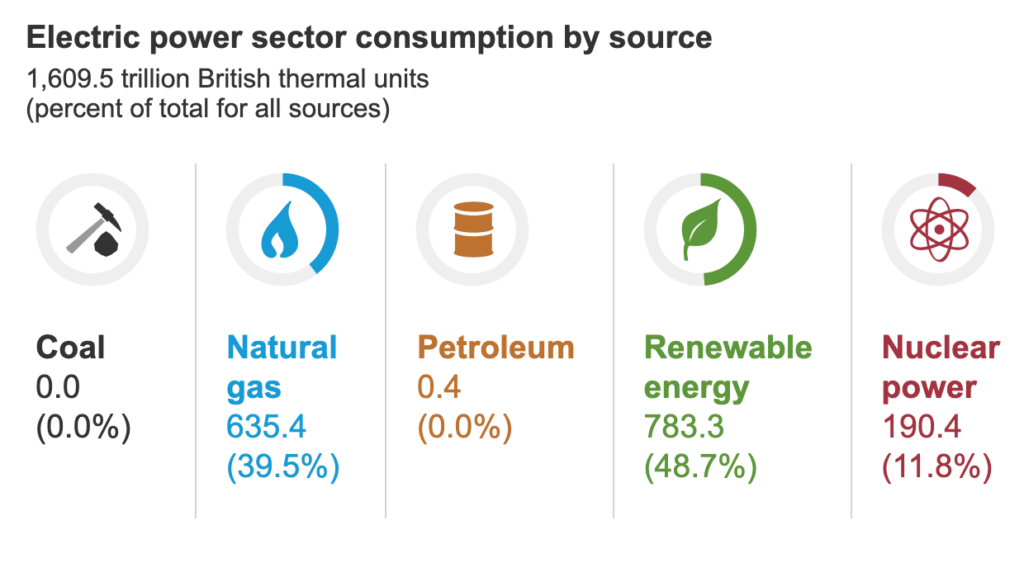
- Different charging habits by EV drivers: In the early days of EV adoption, an estimated 30% of EV owners also had solar panels on their home, but as more people adopt EVs, fewer of them also have solar. More significantly, however, many utilities offer time of use (TOU) rates to incentivize EV owners to charge their vehicles overnight rather than during peak periods during the day. So an EV driver with solar might actually charge their EV beginning at midnight when the main electricity source from a utility might be coal or natural gas, rather than solar, for example.


12 Responses
Can’t think of a bigger waste of time than debating whether or not EV’s are charged from fossil fuels. Here’s a fact, nobody cares. The decision to adopt and EV is one of price & functionality. Good god man, good luck with this junk.
Thanks for the intelligent and respectful comment on my article Jack. People do and do not buy EVs for a variety of reasons. And people debate many aspects surrounding EVs from “well to wheels” calculations to battery material sourcing to what sources of electricity actual power EVs. I’m glad you have no concerns about the source of electricity – though regardless of your interests around EVs, many organizations include the Union of Concerned Scientists look at this issue frequently. It is in fact an important question to answer.
I thought it was a very interesting and useful article.
I have done a variation of Lauren’s calculation, with a similar result. It is a comparison of the states with the highest levels of CO2 emissions per capita ( “Brown States” = Alaska, Indiana, Iowa, Kentucky, Louisiana, Montana, Nebraska, North Dakota, West Virginia, and Wyoming) with states exhibiting the lowest levels (“Green States = California, Connecticut, Maryland, Massachusetts, New Hampshire, New York, Oregon, Rhode Island, Vermont, and Washington). Brown states average five times the emissions, while EV market share is five times as great in green states. The full report is at Brown States – Green States – Google Docs
How many of those renewable energy power plants are powered and supported by coal, thermo and hydro power plants?
Hydro is renewable. Most all grids are a huge mix of energy sources so they work together.
Thank you for the interesting thoughts concerning power generation and electric vehicle (ev) demand. I think the relationship between ev demand in a state, and the infrastructure of the state’s power grid is complicated. Decisions on what car to buy is a personal choice, but the power sources in a particular state is mostly a government issue. Vermont is a unique case; much of Vermont’s power production is hydro-electric, but Vermont does not produce enough energy; it consumes 3X more energy than it produces. Lots of wood burning stoves are still in use. In other cases, the French government has encouraged nuclear power generation, whereas the German and American governments have been unfriendly to this power source. To ensure prosperity and raise the quality of life in America, we must have reliable, plentiful, inexpensive energy sources. Expensive energy is inflationary, which is a headwind to improve society. Also, we must have a practical solution on what to do with spent lithium batteries that will need to be recycled or disposed from evs. The whole concept of a pre-owned vehicle changes, when the ev battery has to be replaced; bringing down the cost of the battery would be a definite game changer in favor of evs. A more coherent plan with input from our whole society (government, industry, individuals) would be most welcome. As JFK pointed out, we all share the same planet. I think we all want the same things, including a cleaner environment.
This is very helpful and interesting. But it seems to me that when people plug in their vehicles to charge them, the electric power company has to produce more electricity. So the vehicles are not being charged by the mix of energy sources the power company uses, but rather by the marginal source — the one it uses to increase its electricity generation when more electricity is needed. In general, I would think that would be coal or possibly natural gas.
If this reasoning is incorrect, can you explain why?
Thanks.
Michael, great question and the answer is somewhat complex and varied:
– 1) Most EV drivers charge at home overnight and many utilities offer time of use rates (TOU) for EVs. Overnight there is very little demand for electricity so EVs are generally charged from underutilized existing energy sources during this time. The sources vary for region and utility but could be natural gas, coal, hydro, or wind. But the power comes from existing sources – net new sources are not needed at 2 am.
– 2) Addition of new renewable energy sources are outpacing new natural gas and coal plants. From EIA: The forecast share of generation for U.S. non-hydropower renewable sources, including solar and wind, grows from 13% in 2021 to 17% in 2023. We forecast that the share of generation from natural gas will fall from 37% in 2021 to 34% by 2023 and the coal share will decline from 23% to 22%.
– 3) Perhaps 1 in 3 EV owners also have solar panels on their house – though they may choose to charge overnight instead of during the day from their solar. Though a growing number of EV owners also have battery storage and so can charge at any time for their own solar-generated power stored in the batteries.
– 4) While most public charging stations are powered by whatever the local grid source of energy uses at the time of charge, a growing number of charging locations will use battery storage and trickle charge the storage batteries during low demand times to then charge the EVs during high demand times. Many charging networks are also contracting with renewable energy suppliers (see EVgo).
– 5) Despite the proliferation of electronic devices in our lives, TVs, computers, refrigerators, light bulbs, etc are all becoming much more energy efficient so the demand for electricity per capita has actually been declining. So while EV sales is starting to increase rapidly in the US – there will likely only be about 30 million on the road in the US – versus 295 million gas-powered vehicles. The amount of renewable energy added to the various US grids will generally greatly outpace the addition of new power demands from additional EVs each year.
– 6) And to the last point, most people in the US average about 30 miles of driving per day – and so the incremental power demand is not huge relatively speaking in relation to new added renewable sources. Here is a paper that looked at this question: The overall conclusion the analysis in this paper demonstrates is that, based on historical growth rates, sufficient energy generation and generation capacity is expected to be available to
support a growing EV fleet as it evolves over time, even with high EV market growth.
– 7) In the next few years most utilities will add smart charging programs which enable the utility to charge your EV when power demand is at its lowest.
– 8) And finally, the future of EVs and the grid is what’s called vehicle to grid – which enables EV owners to sell power back to their utility during peak demand times such has during hot summer evenings. These EVs may charge from solar during the day and then send excess energy back to the grid during peak demand times. These programs are being tested today with electric school buses in particular – but I expect V2G to be mainstream by the end of this decade.
I hope this helps. – Loren
Thanks for the detailed reply to my question, Loren. I think, based on your responses, that I failed to make my question completely clear. So I’ll try to be more precise and thus, unfortunately, more wordy.
I assume that power companies adjust the total amount of electricity they generate at any given time to fulfill the demand at that time. So if everyone turns on their air conditioning, for example, the power company must generate more electricity at that time. I also assume that for most power companies most of the time, this will require additional use of fossil fuels, either natural gas or coal. Of course, if they can meet their total requirements at that time without fossil fuels, then this is not an issue. But if they are burning natural gas or coal in addition to using renewable and/or nuclear energy, it is most likely the fossil fuel use that will have to increase to meet the increased demand for, say air conditioning on very hot day. This assumes that they will max out their renewable and nuclear sources if they can before adding (and spending money on) coal or natural gas.
In the same way, if at any particular time people are charging their EVs, the power company will have to generate electricity that it would not have to generate if those EVs weren’t being charged. If they have fossil fuels in their mix of energy sources, these are most likely to be the ones increased since the power company will likely be using all the renewable and nuclear power it can already.
In a similar fashion, a person who has solar panels on their house is generating the same amount of electricity and adding it to the grid, no matter how much electricity that person is using at any particular time. So if that person increases electricity usage by, for example, charging their EV, then it’s the power company, not the person’s solar panels, that has to supply the additional electricity – again, presumably, by burning more fossil fuel in most cases.
I hope this is clear and that you can explain any errors in this reasoning.
Thanks again for your time and expertise.
So I looked around to try to check out what Michael Peters is claiming here. I found this website which says that the marginal energy source for most of the United States is usually natural gas, but for the “Central Corridor” states of the Southwest Power Pool it’s coal.
https://sustainability.stackexchange.com/questions/7112/what-is-marginal-energy
Wikipedia says that the Southwest Power Pool includes, “all of the states of Kansas and Oklahoma, and portions of New Mexico, Texas, Arkansas, Louisiana, Missouri, South Dakota, North Dakota, Montana, Minnesota, Iowa, Wyoming, and Nebraska.”
So if this is right, then that would mean that charging an EV will cause the power company to burn more natural gas unless you live in one of those places where it’s coal.
Thanks, Alex Joseph, for that interesting information about where the marginal energy source for electricity production is natural gas and where it is coal. I was inspired to find out more about this issue.
I found a report from the Union of Concerned Scientists, which I downloaded from here:
https://www.ucsusa.org/sites/default/files/attach/2015/11/Cleaner-Cars-from-Cradle-to-Grave-full-report.pdf
Numbers given in this report imply that where coal is the marginal energy source for electricity an EV is little, if at all, better than many standard gasoline-powered vehicles on the market in terms of greenhouse gas emissions. It also implies that many hybrid vehicles are similar to EVs in their greenhouse gas emissions where natural gas is the marginal energy source, as it is in most of the United States.
The relevant numbers are in their Table 1 on page 7 where they present the “gasoline miles-per-gallon equivalent” for greenhouse gas emissions from EVs with different fuel sources for generating electricity. For coal, the number is 29, implying that a gasoline-powered vehicle that gets 29 mpg would cause the same greenhouse gas emissions as an electric vehicle powered by coal-generated electricity. For natural gas, the number is 58, meaning that a good hybrid vehicle is not that different in greenhouse gas emissions than an EV in most places.
This report is from 2015. I’d really like to know if there are any more recent publications saying whether these numbers are still considered accurate. For example, if electricity production from coal or natural gas has become more efficient, then these numbers would go up, implying that EVs are better for the environment. Maybe Loren or someone else could help find this out.